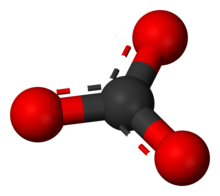
Back Karbonaat Afrikaans كربونات Arabic Carbonatu AST Karbonatlar Azerbaijani کربونات AZB Карбонат Bulgarian Karbonat BS Carbonat Catalan Uhličitany Czech Карбонат CV
 Carbonate anion
| |
 | |
 | |
| Names | |
|---|---|
| Preferred IUPAC name
Carbonate | |
| Systematic IUPAC name
Trioxidocarbonate[1]: 127 | |
| Identifiers | |
3D model (JSmol)
|
|
| ChemSpider | |
PubChem CID
|
|
| UNII | |
| |
| |
| Properties | |
| CO2−3 | |
| Molar mass | 60.008 g·mol−1 |
| Conjugate acid | Bicarbonate |
Except where otherwise noted, data are given for materials in their standard state (at 25 °C [77 °F], 100 kPa).
| |
A carbonate is a salt of carbonic acid, (H2CO3),[2] characterized by the presence of the carbonate ion, a polyatomic ion with the formula CO2−3. The word "carbonate" may also refer to a carbonate ester, an organic compound containing the carbonate group O=C(−O−)2.
The term is also used as a verb, to describe carbonation: the process of raising the concentrations of carbonate and bicarbonate ions in water to produce carbonated water and other carbonated beverages – either by the addition of carbon dioxide gas under pressure or by dissolving carbonate or bicarbonate salts into the water.
In geology and mineralogy, the term "carbonate" can refer both to carbonate minerals and carbonate rock (which is made of chiefly carbonate minerals), and both are dominated by the carbonate ion, CO2−3. Carbonate minerals are extremely varied and ubiquitous in chemically precipitated sedimentary rock. The most common are calcite or calcium carbonate, CaCO3, the chief constituent of limestone (as well as the main component of mollusc shells and coral skeletons); dolomite, a calcium-magnesium carbonate CaMg(CO3)2; and siderite, or iron(II) carbonate, FeCO3, an important iron ore. Sodium carbonate ("soda" or "natron"), Na2CO3, and potassium carbonate ("potash"), K2CO3, have been used since antiquity for cleaning and preservation, as well as for the manufacture of glass. Carbonates are widely used in industry, such as in iron smelting, as a raw material for Portland cement and lime manufacture, in the composition of ceramic glazes, and more. New applications of alkali metal carbonates include: thermal energy storage,[3][4] catalysis[5] and electrolyte both in fuel cell technology[6] as well as in electrosynthesis of H2O2 in aqueous media.[7]
- ^ International Union of Pure and Applied Chemistry (2005). Nomenclature of Inorganic Chemistry (IUPAC Recommendations 2005). Cambridge (UK): RSC–IUPAC. ISBN 0-85404-438-8. Electronic version.
- ^ Chisholm, Hugh, ed. (1911). . Encyclopædia Britannica (11th ed.). Cambridge University Press.
- ^ Navarrete, N.; Nithiyanantham, U.; Hernández, L.; Mondragón, R. (2022-03-01). "K2CO3–Li2CO3 molten carbonate mixtures and their nanofluids for thermal energy storage: An overview of the literature". Solar Energy Materials and Solar Cells. 236: 111525. doi:10.1016/j.solmat.2021.111525. hdl:10234/196651. ISSN 0927-0248. S2CID 245455194.
- ^ Lambrecht, Mickaël; García-Martín, Gustavo; de Miguel, María Teresa; Lasanta, María Isabel; Pérez, Francisco Javier (2023-08-01). "Temperature dependence of high-temperature corrosion on nickel-based alloy in molten carbonates for concentrated solar power applications". Corrosion Science. 220: 111262. Bibcode:2023Corro.22011262L. doi:10.1016/j.corsci.2023.111262. ISSN 0010-938X.
- ^ Hayakawa, Mamiko; Tashiro, Kenshiro; Sumiya, Daiki; Aoyama, Tadashi (2023-06-18). "Simple methods for the synthesis of N -substituted acryl amides using Na 2 CO 3 /SiO 2 or NaHSO 4 /SiO 2". Synthetic Communications. 53 (12): 883–892. doi:10.1080/00397911.2023.2201454. ISSN 0039-7911. S2CID 258197818.
- ^ Milewski, Jarosław; Wejrzanowski, Tomasz; Fung, Kuan-Zong; Szczśniak, Arkadiusz; Ćwieka, Karol; Tsai, Shu-Yi; Dybiński, Olaf; Skibiński, Jakub; Tang, Jhih-Yu; Szabłowski, Łukasz (2021-04-21). "Supporting ionic conductivity of Li2CO3/K2CO3 molten carbonate electrolyte by using yttria stabilized zirconia matrix". International Journal of Hydrogen Energy. International Workshop of Molten Carbonates & Related Topics 2019 (IWMC2019). 46 (28): 14977–14987. doi:10.1016/j.ijhydene.2020.12.073. ISSN 0360-3199. S2CID 234180559.
- ^ Anodic generation of hydrogen peroxide in continuous flow, DOI: 10.1039/D2GC02575B (Paper) Green Chem., 2022, 24, 7931-7940